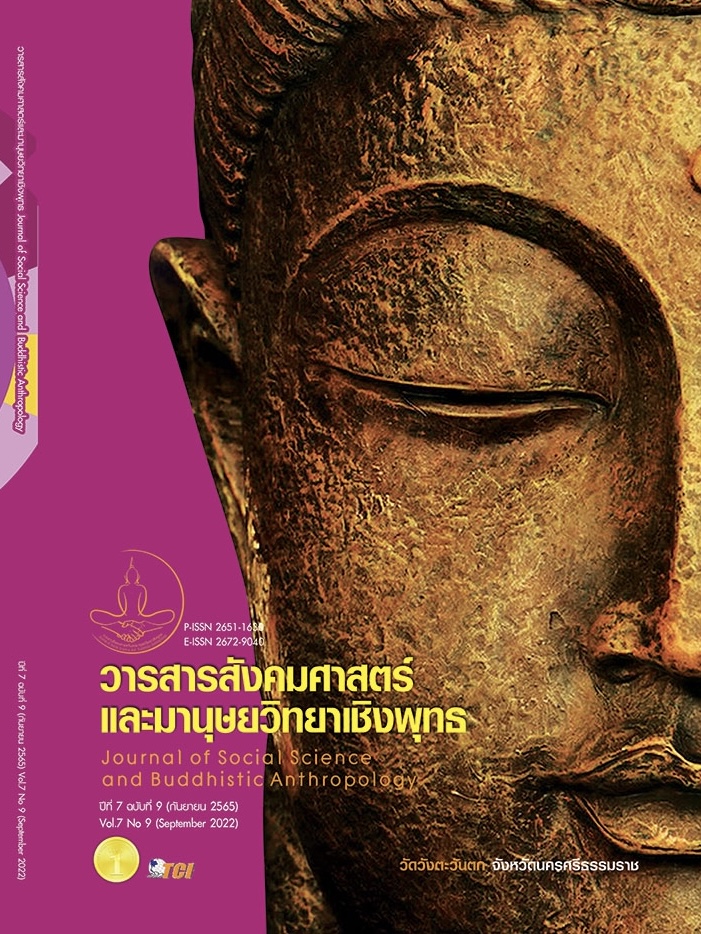A COMPARATIVE STUDY OF METHODS OF CLASSIFYING DISEASE NAMES IN THAI AND CHINESE
Keywords:
Terms of Disease Name, Ethnosemantics, Folk taxonomyAbstract
The objective of this research article were to analyze methods of classifying disease names in Thai and Chinese. To compare the differences in the organization of disease names in Thai and Chinese. including comparing the views of the disease of Thais and Chinese in this study, the villager classification was based on the concept of ethnic semantics. in order to better understand the thinking system that reflects the names of Thai and Chinese people in this study, the researchers collected disease names from media websites. Dictionaries and Books of Introduction to Medicine and let traditional Chinese medicine check the accuracy of the information A total of 189 words were selected to name the disease in both Thai and Chinese within the scope of this study. The results of the villager classification analysis revealed that both Thais and Chinese have similar approaches to viewing the disease. each other and different It can be seen from the methods of classifying the names of diseases in Thai and Chinese with similarities and differences. The hierarchy of disease names in both Thai and Chinese can be classified into 4 hierarchies, namely, the beginning sequence, the category order, the specific order, and the special character order. The categories of diseases that can be classified into specific hierarchy in both Thai and Chinese are cancer, inflammatory disease, fever, gallstones, pox, cyst, rash, parasitic disease, tumor disease, wart, and tuberculosis. of Thais and Chinese is a category named cataracts, measles, hemorrhoids, found only in Thai disease names and the category of skin diseases caused by fungi (癣), ulcers (疮), found only in Chinese names.
References
กองบรรณาธิการพบแพทย์. (2562). โรค A-Z. เรียกใช้เมื่อ 10 มีนาคม 2564 จาก https://www.pobpad.com/%E0%B9%82%E0%B8%A3%E0%B8%84-a-z
กองบรรณาธิการเมดไทย. (2563). รายชื่อโรค อาการ ภาวะต่างๆ ก-ฮ. เรียกใช้เมื่อ 1 มีนาคม 2564 จาก https://medthai.com/%e0%b8%a3%e0%b8%b2%e0%b8%a 2%e0%b8%8a%e0%b8%b7%e0%b9%88%e0%b8%ad%e0%b9%82%e0%b8%a3%e0%b8%84/
คณะกรรมการสาธารณสุขและสุขภาพแห่งชาติ. (2563). ประกาศระบบเรียกชื่อใหม่ของเชื้อโรคไวรัสโคโรน่า 2019 เป็นโควิด-19 (新型冠状病毒肺炎). เรียกใช้เมื่อ 11 มีนาคม 2564 จาก http://www.nhc.gov.cn/xcs/yqtb/list_gzbd.shtml
มนสิการ เฮงสุวรรณ. (2550). คำเรียกประเภทผีของคนไทยในชุมชนวัดสวนแก้ว ต.บางใหญ่ จ.นนทบุรี:การศึกษาแนวอรรถศาสตร์ชาติพันธุ์. ใน วิทยานิพนธ์อักษรศาสตร มหาบัณฑิต. จุฬาลงกรณ์มหาวิทยาลัย.
ริดเดอร์ ไดเจสท์. (2543). ความรู้เรื่องโรค: ทางแก้ ดูแล ป้องกัน. กรุงเทพมหานคร: บริษัทริดเดอร์ ไดเจสท์(ประเทศไทย) จำกัด.
วาสินี มีเครือเยี่ยม และคณะ. (2559). คำเรียกชื่อโรคในระบบแพทย์พื้นบ้านภาคตะวันออกเฉียงเหนือ:กรณีศึกษาตามแนวอรรถศาสตร์ชาติพันธุ์. รมยสาร, 14 (1), 31-42.
วิทย์ เที่ยงบูรณธรรม. (2543). พจนานุกรมโรคและการบำบัด. กรุงเทพมหานคร: อักษรพิทยา.
วิทย์ เที่ยงบูรณธรรม. (2546). พจนานุกรมโรคและสมุนไพร. กรุงเทพมหานคร: รวมสาส์น.
อมรา ประสิทธิ์รัฐสินธุ์ และคณะ. (2555). บุคคลสำคัญและความคิดหลักในอรรถศาสตร์ชาติพันธุ์. กรุงเทพมหานคร: สำนักพิมพ์เอเอ๊สพี.
Lin Z. (2002). Dictionary of Disease Name Comparison of Chinese and WesternMedicine. Beijing. People's Health Publishing House Co. LTD.
Wang Y. (2009). Traditional Chinese Medicine Therapy for Common Diseases (Second Edition). Beijing. People's Health Publishing House Co. LTD.
Yu et al. (2003). Internal Medicine of Integrated Traditional Chinese and Western . Medicine. Beijing: Science Press.
Downloads
Published
How to Cite
Issue
Section
License

This work is licensed under a Creative Commons Attribution-NonCommercial-NoDerivatives 4.0 International License.








